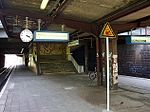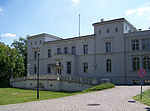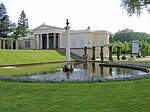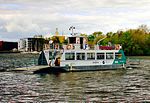Templiner See

Templiner See (German pronunciation: [tɛmˈpliːnɐ zeː] (listen)) is a lake in the state of Brandenburg, Germany. It stretches to the south and west from the centre of the city of Potsdam. The lake is some 5.8 kilometres (3.6 mi) long, with a maximum width of 1.2 kilometres (0.75 mi) and a surface area is 5.11 square kilometres (1.97 sq mi). It lies at an elevation of 29.4 metres (96 ft) above sea level, and has a maximum depth of 6 metres (20 ft). The navigable River Havel flows through the lake, entering it at its northern end adjacent to central Potsdam, and leaving it at its southern end via a short channel to the Schwielowsee between Caputh and Geltow. The lake is crossed by two cable ferries, the Kiewitt Ferry towards its northern end, and the Caputh Ferry at its southern exit. Navigation is administered as part of the Untere Havel–Wasserstraße.At the northern end of the lake, the peninsula of Hermannswerder protrudes into the lake. At about its midpoint, the lake is crossed by the Berlin outer ring railway, using an embankment and bridge. This was built in the 1950s, to bypass West Berlin during the division of Germany.
Excerpt from the Wikipedia article Templiner See (License: CC BY-SA 3.0, Authors, Images).Templiner See
An der Pirschheide, Potsdam Potsdam West
Geographical coordinates (GPS) Address Nearby Places Show on map
Geographical coordinates (GPS)
| Latitude | Longitude |
|---|---|
| N 52.3675 ° | E 13.018333333333 ° |
Address
Eisenbahnbrücke Templiner See
An der Pirschheide
14471 Potsdam, Potsdam West
Brandenburg, Germany
Open on Google Maps










